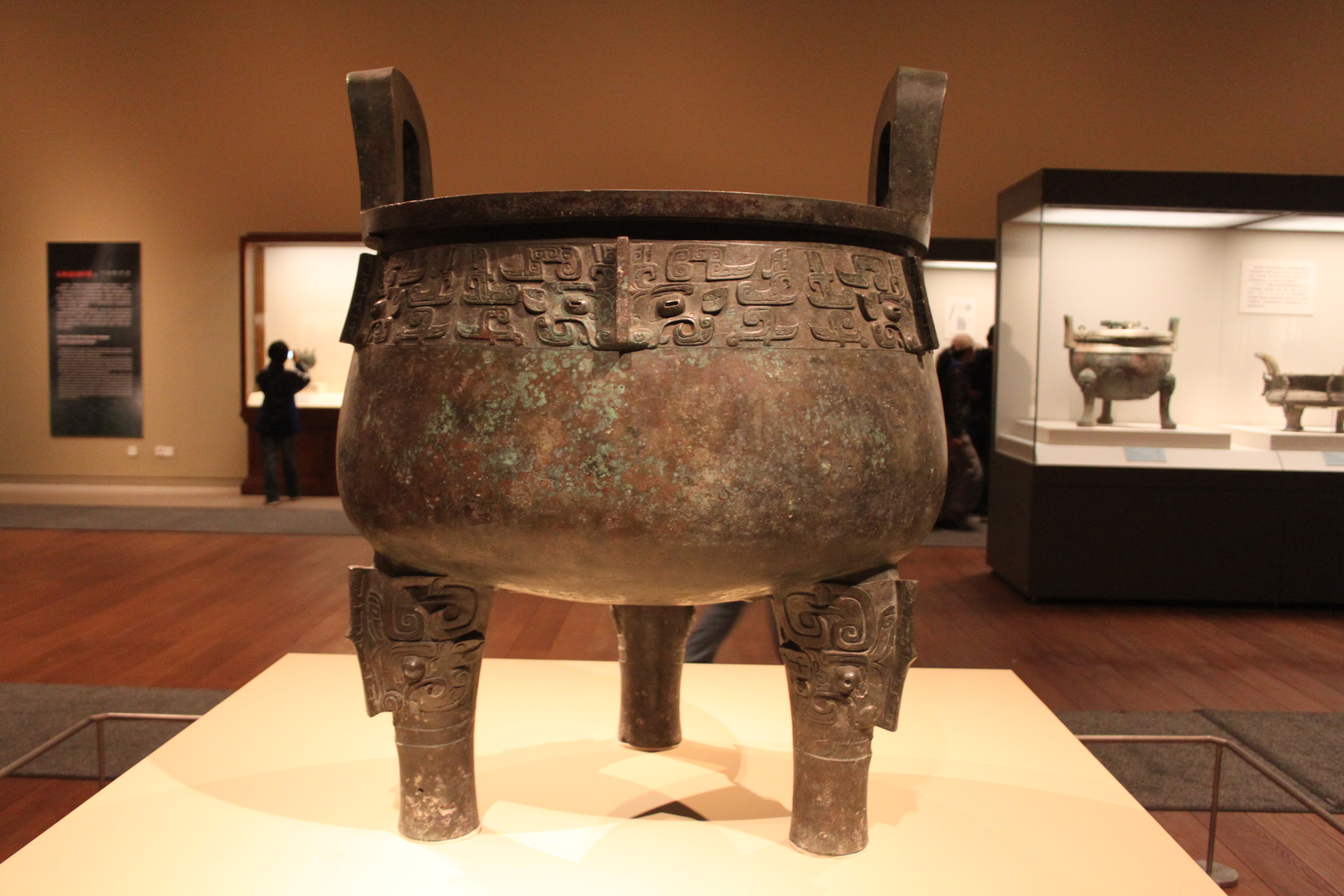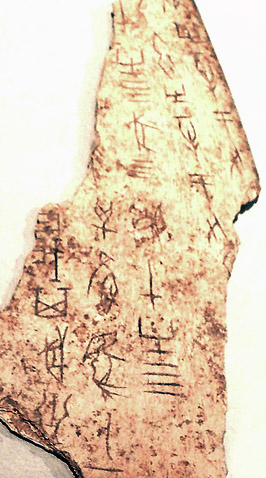|
Oracle Script
Oracle bone script () is an ancient form of Chinese characters that were engraved on oracle bonesanimal bones or turtle plastrons used in pyromantic divination. Oracle bone script was used in the late 2nd millennium BC, and is the earliest known form of Chinese writing. The vast majority of oracle bone inscriptions, of which about 150,000 pieces have been discovered, were found at the Yinxu site located in Xiaotun Village, Anyang, Henan Province. The latest significant discovery is the Huayuanzhuang storage of 1,608 pieces, 579 of which were inscribed, found near Xiaotun in 1993. They record pyromantic divinations of the last nine kings of the Shang dynasty, beginning with Wu Ding, whose accession is dated by different scholars at 1250 BC or 1200 BC. Oracle bone inscriptions of Wu Ding's reign have been radiocarbon dated to 1254–1197 BC±10 years. After the Shang were overthrown by the Zhou dynasty in c. 1046 BC, divining with milfoil became more common, and a much smaller c ... [...More Info...] [...Related Items...] OR: [Wikipedia] [Google] [Baidu] |
Logographic
In a written language, a logogram, logograph, or lexigraph is a written character that represents a word or morpheme. Chinese characters (pronounced '' hanzi'' in Mandarin, ''kanji'' in Japanese, ''hanja'' in Korean) are generally logograms, as are many hieroglyphic and cuneiform characters. The use of logograms in writing is called ''logography'', and a writing system that is based on logograms is called a ''logography'' or ''logographic system''. All known logographies have some phonetic component, generally based on the rebus principle. Alphabets and syllabaries are distinct from logographies in that they use individual written characters to represent sounds directly. Such characters are called ''phonograms'' in linguistics. Unlike logograms, phonograms do not have any inherent meaning. Writing language in this way is called ''phonemic writing'' or ''orthographic writing''. Etymology Doulgas Harper's Online Etymology Dictionary states that the term 'logogram' was derived f ... [...More Info...] [...Related Items...] OR: [Wikipedia] [Google] [Baidu] |
Chinese Bronze Inscriptions
Chinese bronze inscriptions, also commonly referred to as bronze script or bronzeware script, are writing in a variety of Chinese scripts on ritual bronzes such as ''zhōng'' bells and '' dǐng'' tripodal cauldrons from the Shang dynasty (2nd millennium BC) to the Zhou dynasty (11th–3rd century BC) and even later. Early bronze inscriptions were almost always cast (that is, the writing was done with a stylus in the wet clay of the piece-mold from which the bronze was then cast), while later inscriptions were often engraved after the bronze was cast. The bronze inscriptions are one of the earliest scripts in the Chinese family of scripts, preceded by the oracle bone script. Terminology For the early Western Zhou to early Warring States period, the bulk of writing which has been unearthed has been in the form of bronze inscriptions. As a result, it is common to refer to the variety of scripts of this period as "bronze script", even though there is no single such script. The term ... [...More Info...] [...Related Items...] OR: [Wikipedia] [Google] [Baidu] |
Bronzeware Script
Chinese bronze inscriptions, also commonly referred to as bronze script or bronzeware script, are writing in a variety of Chinese scripts on ritual bronzes such as ''zhōng'' bells and '' dǐng'' tripodal cauldrons from the Shang dynasty (2nd millennium BC) to the Zhou dynasty (11th–3rd century BC) and even later. Early bronze inscriptions were almost always cast (that is, the writing was done with a stylus in the wet clay of the piece-mold from which the bronze was then cast), while later inscriptions were often engraved after the bronze was cast. The bronze inscriptions are one of the earliest scripts in the Chinese family of scripts, preceded by the oracle bone script. Terminology For the early Western Zhou to early Warring States period, the bulk of writing which has been unearthed has been in the form of bronze inscriptions. As a result, it is common to refer to the variety of scripts of this period as "bronze script", even though there is no single such script. The term ... [...More Info...] [...Related Items...] OR: [Wikipedia] [Google] [Baidu] |
Western Zhou
The Western Zhou ( zh, c=, p=Xīzhōu; c. 1045 BC – 771 BC) was a royal dynasty of China and the first half of the Zhou dynasty. It began when King Wu of Zhou overthrew the Shang dynasty at the Battle of Muye and ended when the Quanrong nomads sacked its capital Haojing and killed King You of Zhou in 771 BC. The Western Zhou early state was successful for about seventy-five years and then slowly lost power. The former Shang lands were divided into hereditary fiefs which became increasingly independent of the king. In 771 BC, the Zhou were driven out of the Wei River valley; afterwards real power was in the hands of the king's nominal vassals. Civil war Few records survive from this early period and accounts from the Western Zhou period cover little beyond a list of kings with uncertain dates. King Wu died two or three years after the conquest. Because his son, King Cheng of Zhou was young, his brother, the Duke of Zhou Ji Dan assisted the young and inexperienced king as re ... [...More Info...] [...Related Items...] OR: [Wikipedia] [Google] [Baidu] |
Bronzeware Script
Chinese bronze inscriptions, also commonly referred to as bronze script or bronzeware script, are writing in a variety of Chinese scripts on ritual bronzes such as ''zhōng'' bells and '' dǐng'' tripodal cauldrons from the Shang dynasty (2nd millennium BC) to the Zhou dynasty (11th–3rd century BC) and even later. Early bronze inscriptions were almost always cast (that is, the writing was done with a stylus in the wet clay of the piece-mold from which the bronze was then cast), while later inscriptions were often engraved after the bronze was cast. The bronze inscriptions are one of the earliest scripts in the Chinese family of scripts, preceded by the oracle bone script. Terminology For the early Western Zhou to early Warring States period, the bulk of writing which has been unearthed has been in the form of bronze inscriptions. As a result, it is common to refer to the variety of scripts of this period as "bronze script", even though there is no single such script. The term ... [...More Info...] [...Related Items...] OR: [Wikipedia] [Google] [Baidu] |
Oracle Mu4 Eye
An oracle is a person or agency considered to provide wise and insightful counsel or prophetic predictions, most notably including precognition of the future, inspired by deities. As such, it is a form of divination. Description The word ''oracle'' comes from the Latin verb ''ōrāre'', "to speak" and properly refers to the priest or priestess uttering the prediction. In extended use, ''oracle'' may also refer to the ''site of the oracle'', and to the oracular utterances themselves, called ''khrēsmē'' 'tresme' (χρησμοί) in Greek. Oracles were thought to be portals through which the gods spoke directly to people. In this sense, they were different from seers (''manteis'', μάντεις) who interpreted signs sent by the gods through bird signs, animal entrails, and other various methods.Flower, Michael Attyah. ''The Seer in Ancient Greece.'' Berkeley: University of California Press, 2008. The most important oracles of Greek antiquity were Pythia (priestess to Ap ... [...More Info...] [...Related Items...] OR: [Wikipedia] [Google] [Baidu] |
Shang Bronze And Oracle Script
The Shang dynasty (), also known as the Yin dynasty (), was a Chinese royal dynasty founded by Tang of Shang (Cheng Tang) that ruled in the Yellow River valley in the second millennium BC, traditionally succeeding the Xia dynasty and followed by the Western Zhou dynasty. The classic account of the Shang comes from texts such as the ''Book of Documents'', ''Bamboo Annals'' and '' Records of the Grand Historian''. According to the traditional chronology based on calculations made approximately 2,000 years ago by Liu Xin, the Shang ruled from 1766 to 1122 BC, but according to the chronology based upon the "current text" of ''Bamboo Annals'', they ruled from 1556 to 1046 BC. Comparing the same text with dates of five-planet conjunctions, David Pankenier, supported by David Nivison, proposed dates of the establishment of the dynasty to 1554 BC. The Xia–Shang–Zhou Chronology Project dated the establishment to c. 1600 BC based on the carbon-14 dates of t ... [...More Info...] [...Related Items...] OR: [Wikipedia] [Google] [Baidu] |
Oracle Bones
Oracle bones () are pieces of ox scapula and turtle plastron, which were used for pyromancy – a form of divination – in ancient China, mainly during the late Shang dynasty. ''Scapulimancy'' is the correct term if ox scapulae were used for the divination, ''plastromancy'' if turtle plastrons were used. Diviners would submit questions to deities regarding future weather, crop planting, the fortunes of members of the royal family, military endeavors, and other similar topics. These questions were carved onto the bone or shell in oracle bone script using a sharp tool. Intense heat was then applied with a metal rod until the bone or shell cracked due to thermal expansion. The diviner would then interpret the pattern of cracks and write the prognostication upon the piece as well. Pyromancy with bones continued in China into the Zhou dynasty, but the questions and prognostications were increasingly written with brushes and cinnabar ink, which degraded over time. The oracle bones bea ... [...More Info...] [...Related Items...] OR: [Wikipedia] [Google] [Baidu] |
Chinese Academy Of Social Sciences
The Chinese Academy of Social Sciences (CASS) is a Chinese research institute and think tank. The institution is the premier comprehensive national academic research organization in the People's Republic of China for the study in the fields of philosophy and social sciences, with the obligation of advancing and innovating in the scientific research of philosophy, social sciences and policies. It was described by '' Foreign Policy'' magazine as the top think tank in Asia. CASS is under the auspices of the State Council of the People's Republic of China. It is the country's second oldest such institution, after the Shanghai Academy of Social Sciences in Shanghai. It also holds the Graduate School of Chinese Academy of Social Sciences and later become the University of Chinese Academy of Social Sciences. History The CASS was established in May 1977, based on the 14 research units of the Department of Philosophy and Social Sciences of the Chinese Academy of Sciences, with the aim ... [...More Info...] [...Related Items...] OR: [Wikipedia] [Google] [Baidu] |
Oraculology
(甲骨学) is a humanities discipline that focuses on the Chinese Upper Antiquity oracle characters. Oracle bone science can be divided into a narrow sense of oracle bone science and a broad sense of oracle bone science. In the narrow sense, the study of oracle bone script is limited to the study of oracle bone script itself, and it is a discipline of paleography. This includes the integration of theories, research methods and materials from various disciplines, such as paleography, history, archaeology, historical culture, historical literature, and cultural anthropology, to thoroughly study the historical and cultural background of the oracle bones and some of the patterns of the oracle bone divination. It is a diversified and specialized discipline. In the early days of oracle bone discovery, oracle bones were called "qiwen", and the study of oracle bones was called "''qiology''". In 1931, Zhou Yitong proposed for the first time that "oracle bone science" was an independent d ... [...More Info...] [...Related Items...] OR: [Wikipedia] [Google] [Baidu] |



